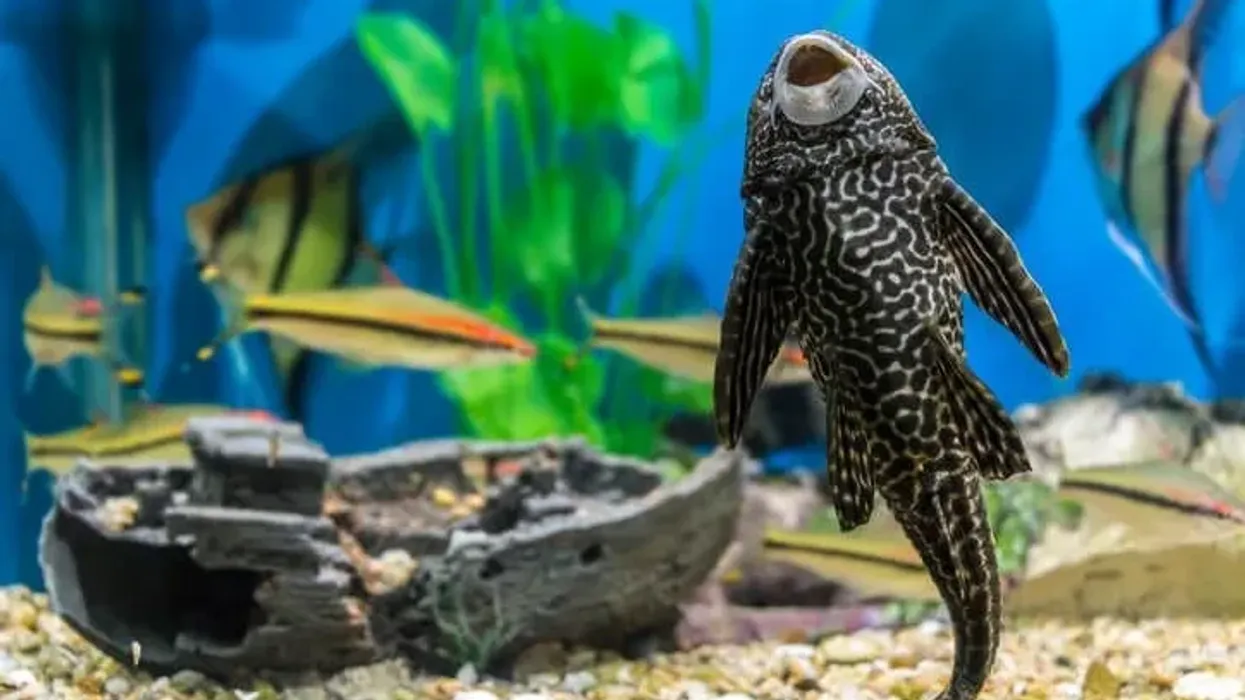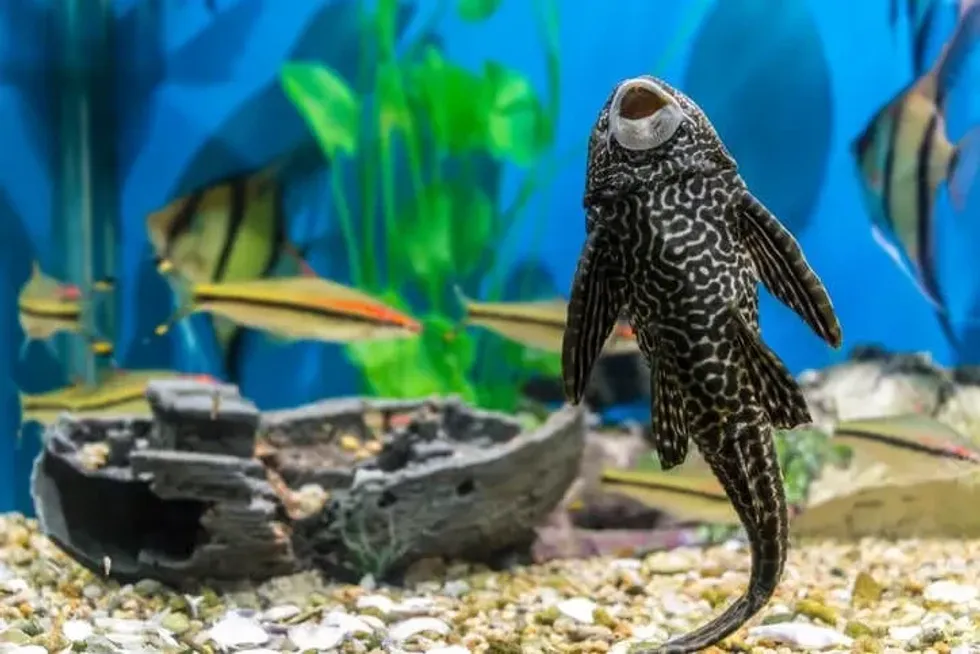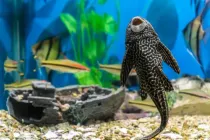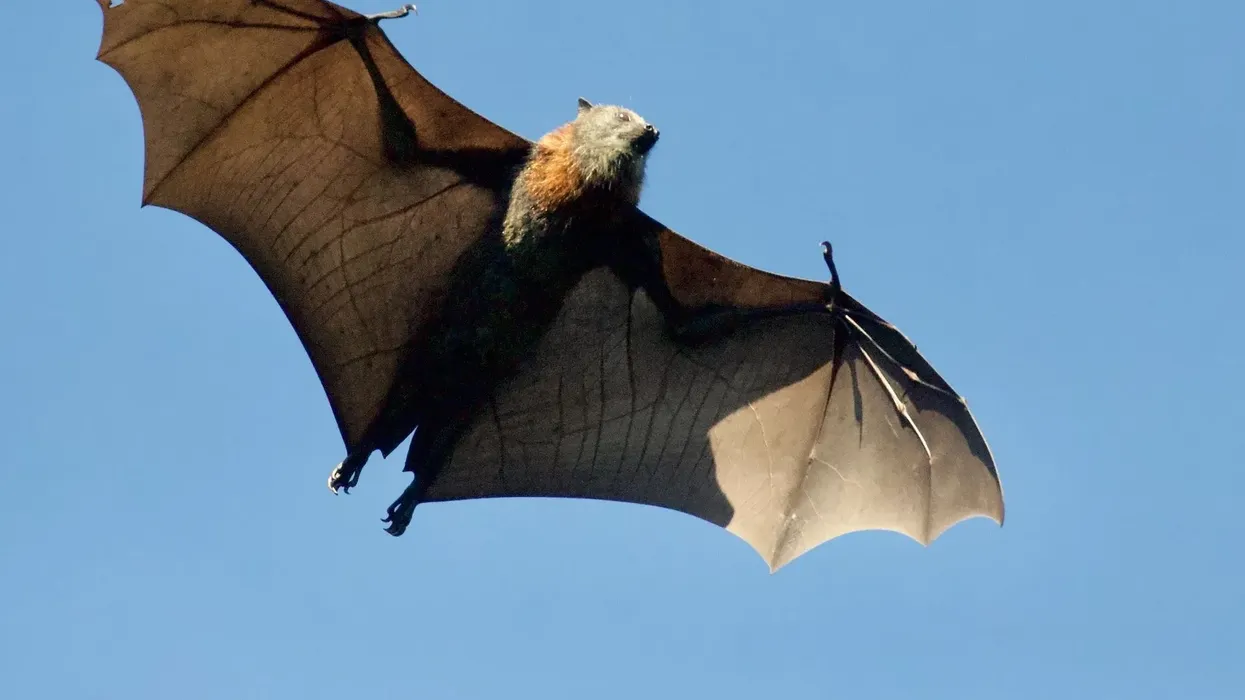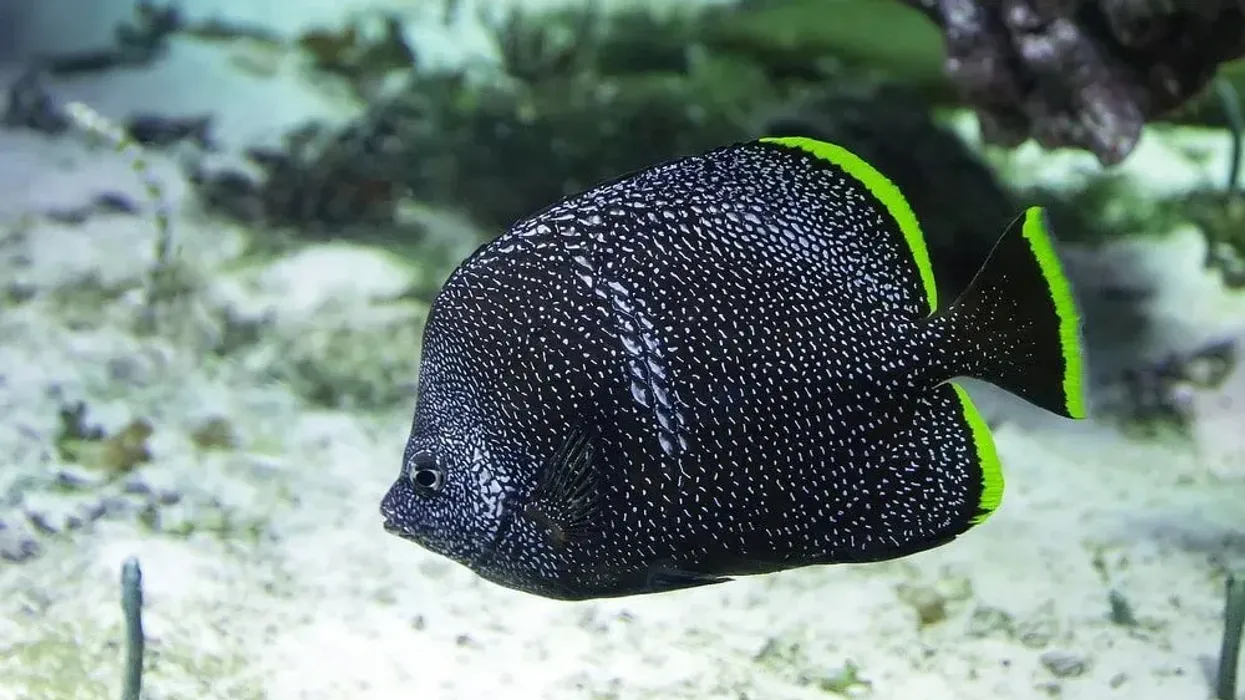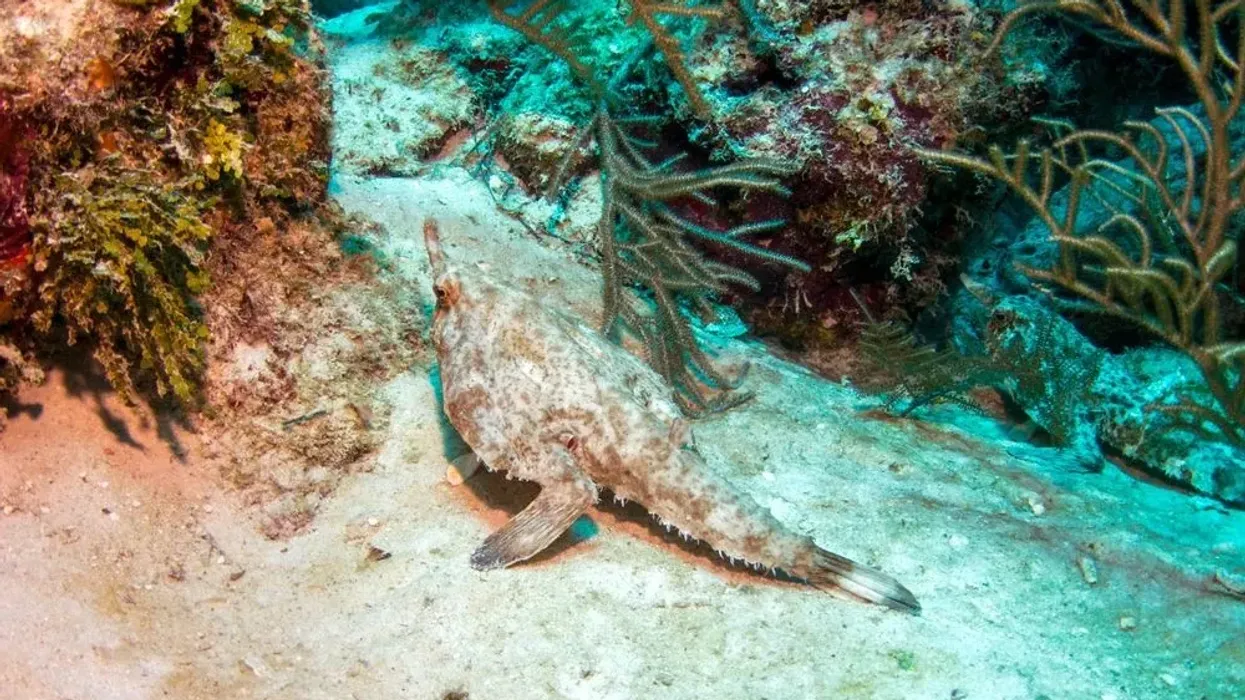Fun Suckermouth Catfish Facts For Kids
The suckermouth catfish (Hypostomus plecostomus), also known as the common pleco, is a fish with its native range in the tropical waters of South America. They are named for their specialized mouth, which is shaped like a suction cup.
Their mouth allows them to live in very fast-moving waters as well. These fish are extremely adaptable and can be found in all kinds of freshwater and brackish water habitats. Depending on their distribution, their body colors differ from sandy to dark brown, with spots or stripes.
They have a very large dorsal fin, so they look very ornamental. This has made them a popular aquarium fish.
They also have bony plates of armored scales on the top of their heads and their bodies. This is a trait of all the catfish in the family Loricariidae. This makes them very difficult to be swallowed by other wildlife and even their natural predators.
As a result of the aquarium trade, these fish have been introduced into the waters of a lot of countries around the world. Because of their adaptability, the suckermouth catfish have a wide distribution.
However, the native range fish of these waters have suffered along with their habitats. In many spaces like Texas, the suckermouth catfish has the status of an invasive species because they are non-indigenous aquatic species that affect native species.
You'll find in this article information such as suckermouth catfish's common name, suckermouth catfish in freshwater tank, suckermouth catfish water temperature range, suckermouth catfish males dorsal fin, suckermouth catfish as a pet.
Also, check out these redtail catfish facts and Mekong giant catfish facts for kids.
Suckermouth Catfish Interesting Facts
What type of animal is a suckermouth catfish?
The suckermouth catfish (Hypostomus plecostomus) is classified in the family Loricariidae – which means it has the bony plates on its body that make it an armored catfish. Some other catfish are Mekong giant catfish, blue catfish, and cory catfish.
What class of animal does a suckermouth catfish belong to?
A suckermouth catfish is a type of tropical fish, belonging to class Actinopterygii.
How many suckermouth catfish are there in the world?
There are a lot of these plecos in the wild in South America. They have also been introduced in the waters of other countries. For this reason, the numbers of these fish haven’t been counted.
Where does a suckermouth catfish live?
The suckermouth catfish (Hypostomus plecostomus) lives in both freshwater and brackish rivers and streams.
What is a suckermouth catfish's habitat?
The plecos, as the suckermouth catfish Hypostomus plecostomus are known, have a wide distribution of habitats.
Originally, these fish are native to the tropical freshwaters, rivers, and streams of north-eastern South America. So they are native to the climates of the tropical rainforest. But they have been introduced to the waters of a lot of Asian and European countries in the world along with their cousins the Pterygoplichthys.
They are found near the bottoms of freshwater rivers and streams – both slow and fast moving. They can be also found in brackish and polluted waters.
The plecos live in lakes and swamps as well. In areas like Florida and Texas in the USA, they have the status of invasive species. In Texas, their distribution can be seen in the rivers and streams of Bexar County, Comal County, Hays County and Val Verde County.
Who do suckermouth catfish live with?
The Plecostomus Suckermouth Catfish are solitary. They can get very aggressive with other fish of the family Loricariidae like the Pterygoplichthys or Sailfin pleco. During reproduction, both the male and the female will guard the eggs, but that is the only time these fish come together.
In aquariums with other fishes, they are peaceful and stick to themselves.
How long does a suckermouth catfish live?
The suckermouth catfish (Hypostomus plecostomus) live long.
Very few animals are willing to risk the bony plates of the armored scales on the head and body of this fish. They have a lifespan of 10 – 15 years.
How do they reproduce?
Like most fish, the suckermouth catfish (Hypostomus plecostomus) lays eggs. The fish will burrow into the banks or rivers and streams. They make caverns when spawning so that the females can be safe and spawn their egg mass.
There are around 500-700 eggs in one mass. The male fertilizes these eggs after spawning is complete. Both the male and the female guard their family of eggs till they hatch.
The females can spawn or lay their eggs more than once a year.
What is their conservation status?
As the suckermouth catfish (Hypostomus plecostomus) is abundant as non-indigenous aquatic species in many areas. In fact, it has the status of invasive species in most regions outside South America like Texas and a lot of Asian countries where they were introduced. So their conservation status is not a matter of concern. They have been classified as Not Evaluated.
Suckermouth Catfish Fun Facts
What do suckermouth catfish look like?
The plecostomus suckermouth catfish, also known as common plecos, live in a lot of different places. Depending on where they live, their colors are different. All plecos have a large dorsal fin and a suction cup mouth which is formed by a modified lip disc. Their dorsal fins are their most attractive feature.
They all also have bony plates of armored scales everywhere except their belly, which makes them very hardy. These scales are typical of all catfishes in the family Loricariidae, including the Pterygoplichthys.
They are usually different shades of brown to better merge with the riverbanks where they live. They may also have spots of different colors like black, brown, or yellow. These patterns make for excellent camouflage in rivers, streams and lakes, and even aquarium tanks with lots of plants.
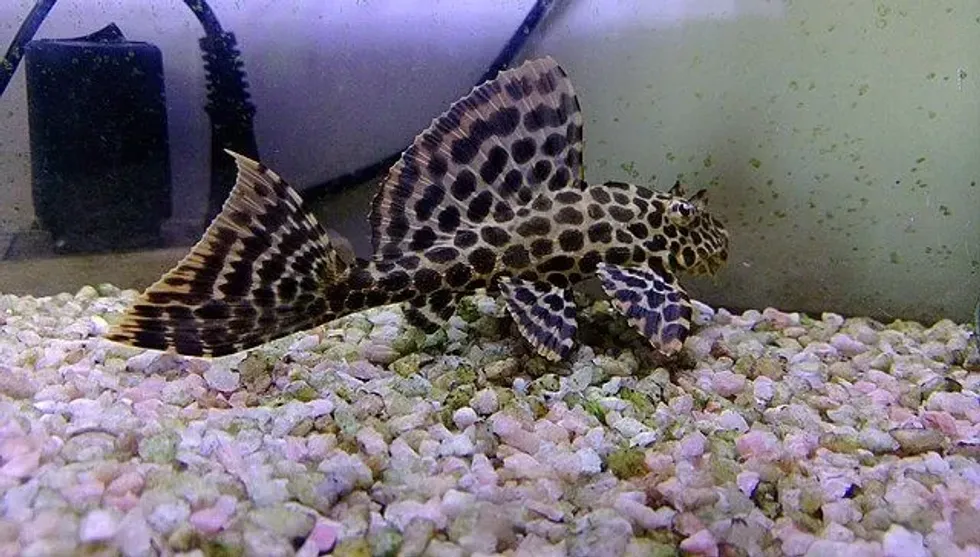
How cute are they?
With their armored scales on their head and body and suction cup mouth due to a modified lip disc, the suckermouth catfish (Hypostomus plecostomus) or plecos are definitely not cute.
Their dorsal fin and colors may make people think of them as beautiful. They can be lovely additions to fish tanks. Though they do not have any features to make them adorable.
How do they communicate?
The suckermouth catfish, like others in the family Loricariidae and other catfishes, can produce different types of sounds. They are also able to tell how far away a sound came from, and from which direction.
This fish uses different parts of its body like its swim bladder and fins to make these sounds. Usually, these sounds are made during fights or breeding season.
How big is a suckermouth catfish?
A suckermouth catfish can reach up to 20 in (50 cm) in length. In contrast, goldfish grow to about 14 in (35cm) in the wild. This makes suckermouth catfish, Hypostomus plecostomus, about 0.7 times bigger than goldfish.
How fast can a suckermouth catfish swim?
There is no specific data about the speed at which a suckermouth catfish (Hypostomus plecostomus) can swim.
How much does a suckermouth catfish weigh?
A suckermouth catfish can weigh up to three pounds. Goldfish may reach up to 2lb (1kg) in weight at the most. This makes the suckermouth catfish 0.6 times bigger than the goldfish in weight.
What are the male and female names of the species?
Male fish are called males and female fish are called females. There are no specific names for the males and females of any fish species.
What would you call a baby suckermouth catfish?
All baby fish are called by different names depending on their stage of growth, regardless of the species. When they are first hatched, baby fish are known as fry. When they eventually grow fins and their scales to become juvenile fish, they are known as fingerlings.
What do they eat?
The suckermouth catfish aren’t especially picky about their food. Their distribution is wide, so they eat based on the availability of food at the location. They are herbivorous omnivores, which means they eat aquatic plants but are also known for feeding on small crustaceans.
Their natural diet is algae and aquatic plants that they can rasp at with their suction-cup mouths. When available, they will also catch small shellfish or crustaceans and eat them.
Are they dangerous?
The plecos or suckermouth catfish (Hypostomus plecostomus) are typically docile with members of other fish species. They make get aggressive with other catfish species if they are in the same tank, or in the same area of the rivers or streams.
They have venom in their pectoral fins and can sting you but this only causes slight discomfort, no serious danger.
However, the real danger of these fish is to local wildlife and habitats in places where they are nonindigenous aquatic species. This is because they have the status of invasive species in places like Texas, Florida, and a lot of Asian countries.
Because of trade for aquariums, these species have been accidentally introduced to the waters of over 17 countries in Asia and Europe. They are long-lived and their natural predators avoid them. They also lay a lot of eggs. This means that their numbers always increase, no matter where they live.
For instance, in the USA, these fish were introduced to Florida in the 1950s. The data suggests that there are now three major types of catfish in the warm waters of Florida’s rivers, streams and ponds. These are the sailfin catfish, the vermiculated sailfin, and the suckermouth catfish.
In Florida, there are no regulations regarding this fish. The warm waters and lack of natural predators in Florida’s rivers, ponds and lakes have meant that these fish continue to increase in numbers.
Their digging and burrowing for egg-laying can cause erosion in the riverbeds. This also clouds the water. Their presence also reduces the amount of native algae and aquatic plants in the region.
This disturbs the native range of wildlife and plant species, either by the changes to the habitat or due to extra competition for food. Over time, the numbers of local species begin dying out because they can’t thrive.
Would they make a good pet?
Their ornamental features like their patterns and large fins are the reason why this species is so popular among aquarium keepers.
These fish grow easily and live for a long time. They are also easy to take care of, so they can make good pets.
Did you know...
There are over 890 recognized species of catfish in the world. They are of the family Loricariidae and are known as Loricariids. and the suckermouth catfish (Hypostomus plecostomus) is one of them!
The suckermouth catfish is also known as the ‘janitor fish’. This is because when kept in tanks, this species of fish will clean the algae off by feeding on it.
Armored catfish are good to eat, especially with some seasoning and butter.
Plecos can have different types of teeth depending on their diet and the availability of food in their habitat. The vegetarians who eat only plants have fine teeth. The omnivores have broad teeth, and the carnivores have hooked teeth. In places like lakes, ponds or swamps where the suckermouth catfish feeds on wood, their teeth are like spatula.
This fish species has a lot of difficulty breeding in captivity. However, in the wild, they breed easily, and do not need any specific conditions to survive.
What are other common names for suckermouth catfish?
Suckermouth catfish (Hypostomus plecostomus) are known as plecostomus or the common pleco. Typically, they are just referred to as plecos.
Can suckermouth catfish live with other fishes?
The suckermouth catfish Hypostomus plecostomus is a peaceful fish species. They are bottom dwellers. With their bony plates of armored scales and large size, they are typically unbothered by other fish, except larger catfish or sea bass.
In aquariums, they will leave the other fishes alone for the most part, but they do need a lot of space. Large loricariids can get aggressive if they don’t have enough space.
They can get aggressive with their own kind. In the wild, they are solitary creatures that come together only for breeding. But they will not harass other species of fish.
Here at Kidadl, we have carefully created lots of interesting family-friendly animal facts for everyone to discover! Learn more about some other fishes from our catfish facts and congo tetra facts pages.
You can even occupy yourself at home by coloring in one of our Suckermouth Catfish coloring pages.
We Want Your Photos!
More for You
See All
Bachelors in Business Administration

Aashita DhingraBachelors in Business Administration
Based in Lucknow, India, Aashita is a skilled content creator with experience crafting study guides for high school-aged kids. Her education includes a degree in Business Administration from St. Mary's Convent Inter College, which she leverages to bring a unique perspective to her work. Aashita's passion for writing and education is evident in her ability to craft engaging content.
Disclaimer
1) Kidadl is independent and to make our service free to you the reader we are supported by advertising. We hope you love our recommendations for products and services! What we suggest is selected independently by the Kidadl team. If you purchase using the Buy Now button we may earn a small commission. This does not influence our choices. Prices are correct and items are available at the time the article was published but we cannot guarantee that on the time of reading. Please note that Kidadl is a participant in the Amazon Services LLC Associates Program, an affiliate advertising program designed to provide a means for sites to earn advertising fees by advertising and linking to Amazon. We also link to other websites, but are not responsible for their content.
2) At Kidadl, we strive to recommend the very best activities and events. We will always aim to give you accurate information at the date of publication - however, information does change, so it’s important you do your own research, double-check and make the decision that is right for your family. We recognise that not all activities and ideas are appropriate for all children and families or in all circumstances. Our recommended activities are based on age but these are a guide. We recommend that these ideas are used as inspiration, that ideas are undertaken with appropriate adult supervision, and that each adult uses their own discretion and knowledge of their children to consider the safety and suitability. Kidadl cannot accept liability for the execution of these ideas, and parental supervision is advised at all times, as safety is paramount. Anyone using the information provided by Kidadl does so at their own risk and we can not accept liability if things go wrong.
3) Because we are an educational resource, we have quotes and facts about a range of historical and modern figures. We do not endorse the actions of or rhetoric of all the people included in these collections, but we think they are important for growing minds to learn about under the guidance of parents or guardians.
